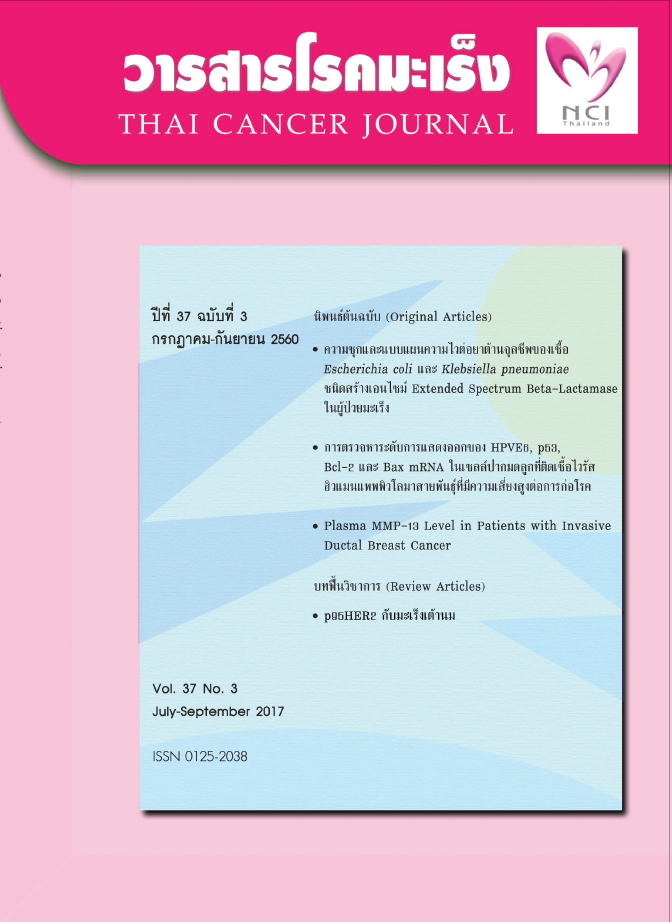The Prevalence and Antibiotic Susceptibility Patterns of Extended Spectrum Beta-Lactamase Producing Escherichia coli and Klebsiella pneumoniae among Cancer Patients
Keywords:
extended spectrum beta-lactamase, Escherichia coli, Klebsiella pneumoniae, antibiotic susceptibility patternsAbstract
The problem of beta-lactam antibiotic-resistant bacteria was mainly found in gram-negative bacilli, especially the family Enterobacteriaceae, which can produce beta-lactamase, which has the ability to reduce the efficacy of antibiotics such as penicillins and cephalosporins, but not carbapenems. This enzyme, extended spectrum beta-lactamase (ESBL) causes the bacteria to resist all beta-lactam antibiotics. The two main bacteria, Escherichia coli (E. coli) and Klebsiella pneumoniae (K. pneumoniae), which can produce ESBLs, are the most common bacteria causing infections in hospitals. In additions, carbapenems e.g., ertapenem, imipenem, and meropenem, are broad-spectrum antibiotics and drugs of choice for the treatment of severe gram-negative bacterial infections. This study aimed to find the prevalence and carbapenem susceptibility patterns of ESBL-producing E. coli and K. pneumoniae isolates collected from clinical specimens of patients at the National Cancer Institute (NCI), during 2013-2016. The phenotypic confirmatory test was used to determine ESBL production and susceptibility testing data were collected from the microbiology laboratory of the NCI. It was found that, of the total 3830 isolated organisms, 788 (20.57%) were isolates of E. coli and 389 (10.15%) isolates of K. pneumoniae. The ESBL-producing strains of E. coli and K. pneumoniae were 51.52% and 33.93%, respectively. The findings of susceptibility to carbapenem indicated that > 90% of ESBL-producing E. coli were susceptible to ertapenem, imipenem, and meropenem while 69% of ESBL producing K. pneumoniae were susceptible to ertapenem and > 80% susceptible to imipenem and meropenem.
References
นิตยา อินทราวัฒนา, มุทิตา วนาภรณ์. โรคติดเชื้อในโรงพยาบาลและสถานการณ์การดื้อยา. วารสารการแพทย์และวิทยาศาสตร์สุขภาพ 2015;22:82-92.
Joseph D.C, Yao, Robert C, Moellering, JR. Antibacterial agents. In: Murray PR, Baron EJ, Pfaller MA, Tenover FC, Yolken RH, eds. Manual of clinical microbiology. 7th ed. Washington DC: American Society of Microbiology 1999. p. 1474-504.
พจมาน ผู้มีสัตย์, ปิยะรัตน์ จิตรภิรมย์, เกรียงศักดิ์ มีพันธ์. การตรวจหาเอนไซม์บีตา-แลคทาเมสชนิดฤทธิ์ขยายและแอมพ์ซีบีตา-แลคทาเมสในเชื้อกลุ่มเอนเทอโรแบคเทอริซีอี. เวชสารแพทย์ทหารบก 2558;68:165-71.
ศิริธร ไทยเจริญ วท.บ. (เทคนิคการแพทย์). Carbapenem-Resistant Escherichai coli ครั้งแรกในโรงพยาบาลพระปกเกล้า. วารสารศูนย์การศึกษาแพทย์ศาสตร์คลินิก โรงพยาบาลพระปกเกล้า 2554;28:238-42.
วีวรรณ อาชีวะ วท.บ. (เทคนิคการแพทย์). ความชุกของเอนไซม์ดื้อยากลมุ่ carbapenems ที่แยกได้จากเชื้อดื้อยา carbapenem resistant Enterobacteriaceae ในโรงพยาบาลพระปกเกล้า ปี พ.ศ. 2555-2556. วารสารศูนย์การศึกษาแพทย์ศาสตร์คลินิก โรงพยาบาลพระปกเกล้า 2559;33:314-25.
สถาบันมะเร็งแห่งชาติ. การรักษามะเร็งตามหลักสากลที่ปฏิบัติกันอยู่ในประเทศไทย. เข้าถึงได้จาก: www.nci.go.th/th/knowledge/treat.html. สืบค้นเมื่อวันที่ 16 มกราคม 2560.
สารานุกรมไทยสำหรับเยาวชนฯ เล่มที่ 9 เรื่องที่ 6โรคมะเร็ง. การรักษาโรคมะเร็ง. เข้าถึงได้จาก: http://saranukromthai.or.th/sub/book/book.php?book=9&chap=6&page=t9-6-infodetail10.html. สืบค้นเมื่อวันที่ 16 มกราคม 2560.
กุลวดี สุระยุทธ์ปรีชา. ภาวะนิวโทรพีเนียและการติดเชื้อในผู้ป่วยมะเร็งเดก็ . รามาธิบดีพยาบาลสาร 2553;16:14-26.
ธีรพงษ์ ตั้งบวรวีรกุล, พยุงศักดิ์ บุญโก้, กิติยา ศรีสมโภชน์, ชุติพันธ์ พันธุ์ประทุม, นลินี ประกอบวณิชกุล, วิน เตชะเคหะกิจ. การติดเชื้อในผู้ป่วยมะเร็งเม็ดเลือดขาวที่มีภาวะไข้จากเม็ดเลือดขาวต่ำใน โรงพยาบาลสุราษฎร์ธานี อุบัติการณ์ของการติดเชื้อ เชื้อก่อโรค และปัจจัยที่มีผลต่อผลการรักษา. ธรรมศาสตร์เวชสาร 2558;15:29-38.
Clinical and Laboratory Standard Institute (CLSI). Performance standards for antimicrobial susceptibility testing twenty third Information supplement (M02-A10 and M07-A8); 2013.
Clinical and Laboratory Standard Institute (CLSI). Performance standards for antimicrobial susceptibility testing twenty fourth Information supplement (M02-A11, M07-A9), and M11-A8; 2014.
Clinical and Laboratory Standard Institute (CLSI). Performance standards for antimicrobial susceptibility testing twenty fifth Information supplement (M02-A12, M07-A10), and M11-A8; 2015.
Clinical and Laboratory Standard Institute (CLSI). Performance standards for antimicrobial susceptibility testing (M02-A12, M07-A10 and M11-A8; 2016.
National Antimicrobial Resistance Surveillance Center (NARS), National Institute of Health, Department of Medical Sciences, Ministry of Public Health, Thailand. Available at: http://narst.dmsc.moph.go.th/.
Accessed January 16, 2017.
Meeta sharma, Sati pathak, Preeti srivastava. Prevalenc and antibiogram of Extended Spectrum β-Lactamase (ESBL) producing Gram negative bacilli and further molecular characterization of ESBL producing Escherichia coli and Klebsiella spp. J Clin Diagn Res 2013;7:2173-7.
มุจรินทร์ ติลกเลิศ, ปาริชาติ ธัญญธาดา. เชื้อดื้อยาในโรงพยาบาลพุทธชินราช พิษณุโลก ระหว่างปี 2550-2552. วารสารเทคนิคการแพทย์ 2553;38:3476-85.
ชัยพร การะเกตุ. ความชุกของเชื้อ K. pneumoniae และ E. coli ชนิดสร้างเอมไซม์ extended spectrum beta lactamase โรงพยาบาลเชียงคำ ระหว่างปี 2554-2555. วารสารโรงพยาบาลพิจิตร 2555;28:21-30.
เดชพิภัทร์ อมรทิพย์วงศ์, พวงมณี จิตตวงศ์พันธ์, วิภัสรา นนทสิทธิ์, ปวีณา มงคลวิสุทธ์, อำไพ สุภาจีน. ความชุกของเชื้อ K. pneumoniae และ E. coli ชนิดสร้างเอนไซม์ Extended-Spectrum Beta-Lactamase จากผู้ป่วยที่เข้ารับการรักษาที่โรงพยาบาลน่าน และโรงพยาบาลชุมชนในจังหวัดน่าน ระหว่าง ปี 2547-2553. วารสารเทคนิคการแพทย์เชียงใหม่ 2554;44:169-75.
จารุกรณ์ วิศาลสวัสดิ์ วท.บ. (เทคนิคการแพทย์). ความชุกและแบบแผนความไวต่อยาต้านจุลชีพของเชื้อ Escherichia coli และ Klebseilla pneumonia ที่สร้างเอนไซม์ Extended spectrum beta-lactamases (ESBL) ในโรงพยาบาลมหาราชนครราชสีมา ประเทศไทย. เวชสารโรงพยาบาลมหาราชนครราชสีมา 2558;37:84-94.
Kaftandzieva A, Trajkovska-Dokic E, Panovski N. Prevalence and molecular charaterzation of extended spectrum beta-lactamase (ESBLs) producing Escherichia coli and Klebsiella pneumoniae. Prilozi 2011;32:129-41.
Shristi Raut, Shishir Gokhale, Bipin Adhikari. Prevalence of extended spectrum beta-lactamases among Escherichia coli and Klebsiella spp isolate in manipal Teaching Hospital, Pokhara, Nepal. J Microbio Infect Dis 2015;5:69-75.
Vishwanath Gurushanthappa, Radhakrishna Manipura, Prasad Subba Rama, Sridhar PN Rao, Krishna Srinivasan. Extended spec beta-lactamase producing Escherichia coli and Klebsiella pneumoniae: A Multi-centric Study Across Karnataka. J Lab Physicians 2014;6:7-13.
Parul Agrawal, AN Ghosh, Satish Kumar, B Basu, K Kapila. Prevalance of extended-spectrum β-lactamase among Escherichia coli and Klebsiella pneumoniae isolates in tertiary care hospital. Indian J Pathol Microbiol 2008;51:139-42.
Yong Chong, Shinji Shimoda, Hiroko Yakushiji, Yoshikiyo Ito, Toshihiro Miyamoto, Tomohiko kamimura et al. Community spread of extended-spectrum β-lactamase-producing Escherichia coli, Klebsiella pneumoniae and Proteus mirabilis a long-term study in Japen. J Med Microbiol 2013;62:1038-43.
Daniel Maina, Paul Makau, Andrew Nyerere, Gunturu Revathi. Antimicrobial resistance patterns in extendedspectrum β-lactamase producing Escherichia coli and Klebsiella pneumoniae isolates in a private tertiary hospital, Kenya. Microbiology Discovery 2013;1:5.
Iraj Alipourfard Nilufar Yeasmin Nili. Antibiogram of Extended Spectrum beta-Lactamase (ESBL) producing Escherichia coli and Klebsiella pneumoniae isolated from hospital sample. Bangladesh J Med Microbiol 2010;4:32-6.
Downloads
Published
Issue
Section
License
บทความทีตีพิมพ์ในวารสารโรคมะเร็งนี้ถือว่าเป็นลิขสิทธิ์ของมูลนิธิสถาบันมะเร็งแห่งชาติ และผลงานวิชาการหรือวิจัยของคณะผู้เขียน ไม่ใช่ความคิดเห็นของบรรณาธิการหรือผู้จัดทํา







